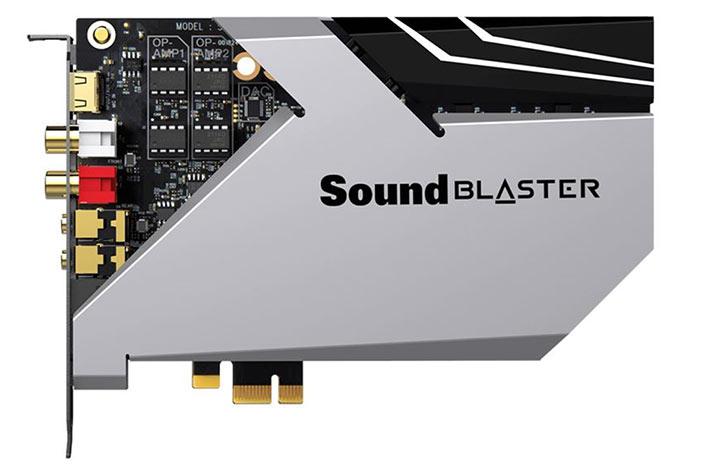As most of you are probably aware,
Creative Labs
, is one of the Founding Fathers of PC Audio and has manufactured sound cards and other audio-related hardware for 30 years. The original
Sound Blaster
was the
de facto
standard for DOS gaming audio almost right from its release in 1989. As high-profile PC games like
Wolfenstein 3D
came out with Sound Blaster compatibility trumpeted on their boxes, the company rose to prominence with its Yamaha OPN and OPL-based FM synthesis sound cards. Fast forward to today, and the house that Sound Blaster Built is still pumping out new and better audio hardware. Today, we're going to take a look at the company's latest flagship audio wunderkind, the just- announced Sound Blaster AE-9.The on-board audio you'll find on many enthusiast-focused motherboards has been solidly in the "good enough" camp for the majority of PC users for ages, but the Sound Blaster AE-9 is not aimed at "good enough." Instead, the AE-9 aims to be the best sound card around to justify its $349.99 recommend price tag. To achieve that goal, Creative outfitted the AE-9 with an ES9038PRO SABRE digital-to-audio converter (DAC) from ESS. The 9038 supports playback for eight simultaneous channels of 32-bit audio at 384 kHz with a 129-dB signal-to-noise ratio (SNR) and a total harmonic distortion of just 0.0001%. Both the SNR and THD ratings are a fair bit better than the $150
Sound Blaster AE-5
. Unfortunately, those ratings start to come back to earth when using the Audio Control Module breakout box, where the SNR drops to 123 dB and the THD comes up to 0.0004%. Those numbers look good very good on paper, and we'll find out how the AE-9 sounds when we get to the listening tests.
Creative Sound Blaster AE-9
Specifications & Features
Interface
PCI Express x1
Dynamic Range
129 dB (Stereo, DAC), 123 dB (Stereo, ACM module)
Total Harmonic Distortion
0.0001% (Stereo, DAC), 0.0004% (Stereo, ACM module)
Sampling Rate DSP Playback
16-bit
/ 44.1, 48, 88.2, 96 kHz |
24-bit
/ 44.1, 48, 88.2, 96 kHz |
32-bit
/ 44.1, 48, 88.2, 96 kHz
Sampling Rate Direct
16-bit
/ 48, 96, 192, 384 kHz |

24-bit
/ 48, 96, 192, 384 kHz |
32-bit
/ 48, 96, 192, 384 kHz
Sampling Rate Recording
Mic Input:
16-bit / 16, 44.1, 48, 88.2, 96 kHz | 24-bit / 44.1, 48, 88.2, 96 kHz | 32-bit / 44.1, 48, 88.2, 96 kHz
Aux and S/PDIF Input:
16-bit / 44.1, 48, 88.2, 96, 192 kHz | 24-bit / 44.1, 48, 88.2, 96, 192 kHz
What U Hear Input:
16-bit / 44.1, 48 kHz | 24-bit / 44.1, 48 kHz
Headphone Amp
Supports 16 - 600 ohms impedance
Connectivity
Main Card:
2 x RCA front L/R channel out, 1 x 1/8" Center / Sub out, 1 x 1/8" Surround L/R out, 1 x Optical S/PDIF out, 1 x Optical S/PDIF in
Audio Control Module (ACM):
1 x 1/8" headset out / microphone in, 1 x 1/8" dedicated microphone in, 1 x XLR / TRS microphone, instrument, balanced line input, 2 x RCA line input
Power
1 x PCI Express 6-pin (required for ACM)
Pricing
$349 - Find It At Amazon
Creative
also blessed the Sound Blaster AE-9 with a bi-amplified pair of Op-Amps to drive high-end headphones. Unlike traditional bi-amplification, which uses multiple amps for different frequency ranges, the AE-9 amplifies the left and right channels separately, which in theory will completely eliminate stereo cross-talk. Because different styles of headphones come with different impedance ratings, the AE-9 also has a three-way toggle that allows owners of sensitive in-ear monitors to reduce impedance while still having the capability to drive high-impedance cans. The card is backed by Nichicon capacitors that live under the AE-9's metal shroud.
With all that output hardware under the hood, it'd be easy to think Creative skimped on the input side, but that doesn't appear to be the case. The card comes with its own breakout box that (along with dedicated headphone outputs and stereo auxiliary inputs) has an XLR / Tip-Ring-Sleeve (TRS) connector for a single microphone or monaural line-level input. The card can capture 16, 24, and 32-bit audio with sampling rates up to 96 kHz. That input also supports optional +48 volt phantom power, which is necessary for condenser microphones. Could this
sound card
also replace portable, USB-powered audio interfaces for audio production? We'll have to try it out to be sure.
Along with the impressive hardware specs, Creative has bundled a host of software features and effects with with Sound Blaster AE-9. The Sound Blaster Command software has pre-configured equalization profiles for various
games
and music genres. We're not usually a fans of these effects, but fortunately you can turn them off in the app. Scout mode tries to give gamers a one-up on their opponents by enhancing audio cues like footsteps by means of dynamic range compression at the quiet end of the spectrum without affecting louder sounds. CrystalVoice, Creative's brand name for its vocal-enhancing and input noise-reduction technologies, is also present. As with other recent Creative products, the BlasterX Acoustic Engine DSP is onboard the AE-9. Just like with the AE-5, the maximum playback fidelity comes down from 384 kHz in direct playback mode to 96 kHz with the DSP active.









